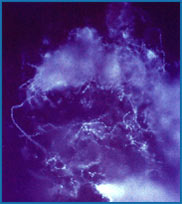Scientists have studied the biology, geology, and chemistry of submarine hydrothermal vent systems intensely since their discovery in the late 1970’s. Deep-sea hydrothermal vents are characterized by large chimneys venting extremely high temperature fluids (350-400°C = 572°F) and “black smoke”, and unusual types of organisms including gigantic tube worms, clams, and crabs. These systems also harbor micro-organisms that use energy sources derived from volcanoes in the seafloor, and include an organism which grows at the highest temperature known for life, 113°C (235°F).
The discovery of the Lost City Hydrothermal Field, near the Mid Atlantic Ridge, in December 2000, provided renewed excitement in the hydrothermal vent community as it represented a completely new type of hydrothermal system. Instead of being driven by volcanic heat below the seafloor, the heat at Lost City, and the fluid flow, appear to be driven by reactions between seawater and the mantle rocks making up the seafloor there. The fluids are have very high pH’s (10) compared to typical hydrothermal vents (pH 4) and contain large amounts of the gases hydrogen and methane. The fluids at Lost City vent through large structures made of calcium carbonate (the same material that corals are made of) that reach 60 m (~180 ft) off the sea floor. The finding of Lost City is exciting for microbiologists because new types of organisms may grow there, and they may have new ways of making a living. The conditions at Lost City are also similar to those suspected for early in Earth’s history, before photosynthesis, and may exist on other planets throughout the universe.
 |
Since the Lost City Field was only very recently discovered, the kinds of questions microbiologists are asking are still in very basic stages. For example, one of the most basic questions that we will address during this expedition is
“Who is there?”
We can answer this question by 1) collecting fluids coming out of the seafloor and chimneys, 2) by collecting samples of the chimneys and underlying mantle rocks. We will also put colonization experiments into the vents to see if we can get microbes to grow within chambers places on the seafloor during our 32-day cruise.
Once we recover these samples, we look at them using a microscope, we try to grow the organisms in different media (liquid microbial food), and we extract and analyze their DNA. Simply identifying which organisms live in different parts of the Lost City System is a huge question for the cruise on the R/V Atlantis in April 2003.
Another important question is, “Can the organisms at Lost City use the energy sources created by the rocks, or the rocks themselves?” In other words, “Can microbes eat rocks?” If they can, this may be important for parts of the Earth where energy sources derived from photosynthesis are not available, like deep in the subsurface of the Earth’s crust. It might also provide guides in the search for life on other planets, even far away from the sun.
Obviously, there is a lot still to be learned about Lost City because only one scientific dive using Alvin has been made there so far. However, great potential exists for making new and exciting discoveries of the microbiology there due to it being such a unique type of hydrothermal system. This expedition should provide a wealth of data to expand our knowledge of the habitable parts of our own planet and allow us to speculate as to where and how else life might exist elsewhere.